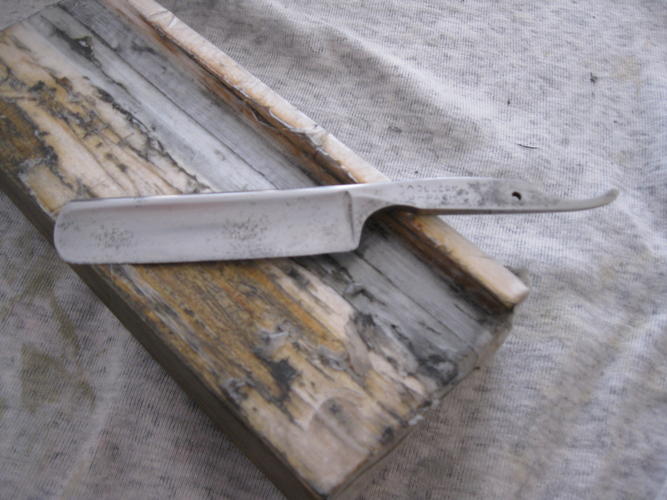Results 11 to 16 of 16
-
10-18-2013, 11:03 PM #11

Got some pics of the razor from attached
Any thoughts or comments welcome
Does anybody know a possible makers name and approximate years of manufacture?




-
10-19-2013, 05:10 AM #12Senior Member



- Join Date
- Apr 2012
- Location
- Diamond Bar, CA
- Posts
- 6,553
Thanked: 3215
Rick, looks like Cell rot on the blade, notice the straight line of pitting near the spine, in photos 2 and 3. That line is the part of the blade that was not between the scales when closed, the pitted part was.
Cell rot will attack the thinnest part of the steel most aggressively, the edge. You possibly could remove enough of the edge until you get to good steel.
If you want to experiment you could tape the spine and hone on the 1k and keep checking the edge, until there is no chipping or you could breadknife removing a 1/16 the of an inch at a time and bevel set, again checking for chipping.
It may be that you will have to remove too much metal to remove all the pitting but before doing all that work make sure you will be able to get an edge on the blade.
Personally I do not purchase any blade with cell rot, the potential for success is slim.
Glen said it best in another thread, and I do not recall his words exactly, but the gest was, Successful Restoration begins at purchase. Buy the razor in the best condition you can, for the money you want to spend, they are out there.
-
10-19-2013, 06:02 AM #13

Euclid, Thanks for the feedback on this blade. I was clearly mistaken thinking this pitting was water damage. After some more reading I see cell rot certainly would be the culprit here.
This blade may still be worth restoring though I will not look for a super shiny result.
First of all I will try honing past the problem cell rot though I think I could be going more than an hour on this one to find good steel and set the bevel.
Who knows what can happen until we try.
On the plus side of things I do have some much nicer candidates available for a restore.
the learning continues
-
10-19-2013, 06:27 AM #14Senior Member

- Join Date
- Oct 2011
- Location
- Moses Lake Wa.
- Posts
- 162
Thanked: 20
Before you cut try this as that it worked for me on a blade that wouldn't take an edge at all. take and old or cheep stone and flatten the edge. I used the saw method to square out the blade and to get down to a better metal. then I started out resetting the bevel with about 25 strokes with a 220 grit, the progressed threw all my stones to 12000. it took a great edge and is one of my best shavers.
-
10-19-2013, 11:25 AM #15

I'm with Euclid: cell rot. This is a bit of a guess, but judging from the pictures, it looks to me like the last 2 cm of the edge at the toe have been rotten through, as the cell rot from the backside shows at the edge on the front side as well. That confirms your idea of cutting off the toe, that would be my way to go, over reducing the width of the blade by several millimetres. Short razors look wider and thus cooler
 You could even try a kamisori shape.
I want a lather whip
You could even try a kamisori shape.
I want a lather whip
-
10-20-2013, 03:46 AM #16

The more I look at this razor and read the member feedback the more I seem to see wrong with this one.
Today I started honing on my 1K hone and after checking bevel by TNT looked at the edge under my loupe.
This one has white and blue light on it. As I look at the edge using the blue I see light reflecting back at the lens.
In other sections I see what appear to be holes, the light is showing a much lighter shade of blue at these points.
Using the white lights showed some tiny pinholes appearing through the edge.
It seems this razor is doomed to be a letter opener/package opener.
I may shorten it anyway and try my hand at making a fixed handle on it (Kamisori style) with the Monkey tail trimmed off
So even now all is not totally lost I will still learn something from this exercise
Thanks to all for their words of wisdom and helpful tips


 3Likes
3Likes LinkBack URL
LinkBack URL About LinkBacks
About LinkBacks








 Reply With Quote
Reply With Quote